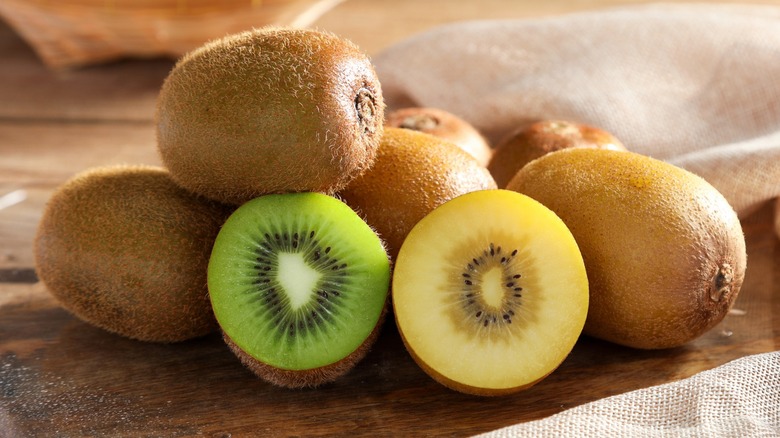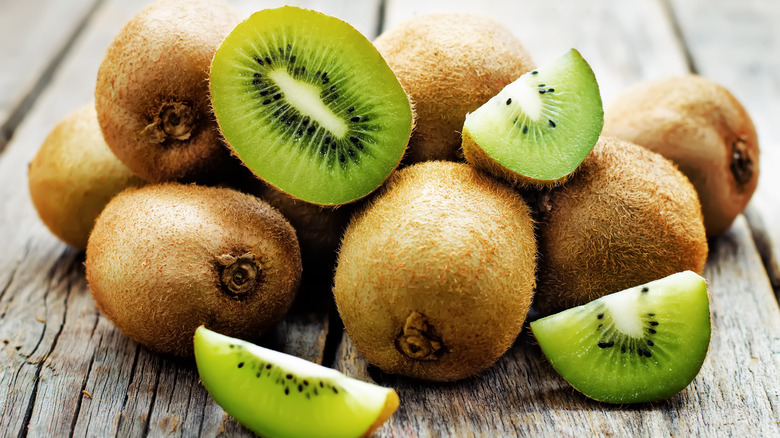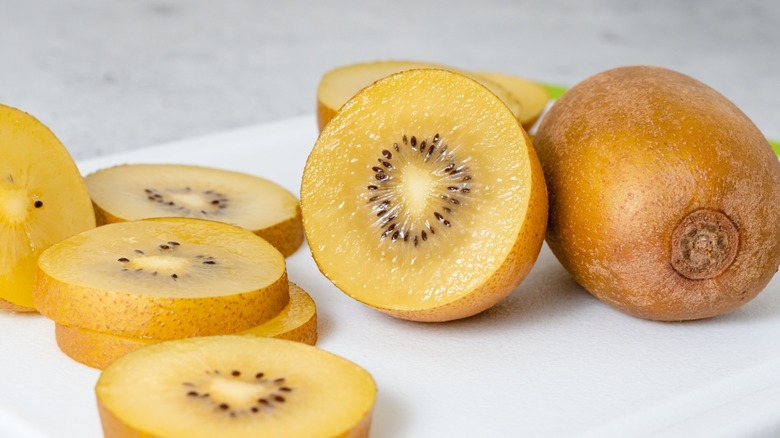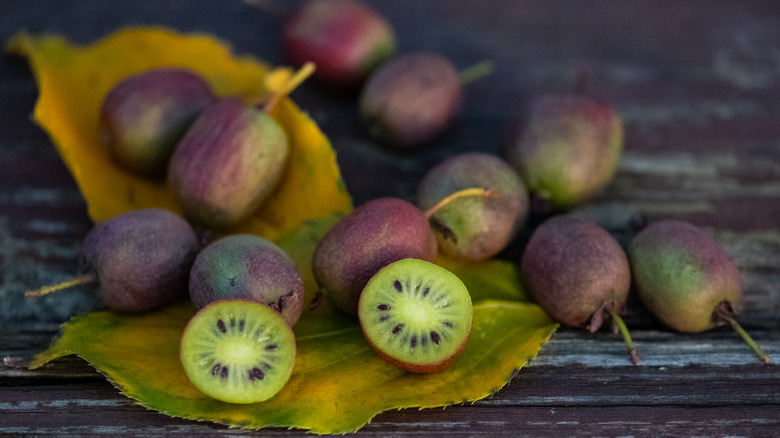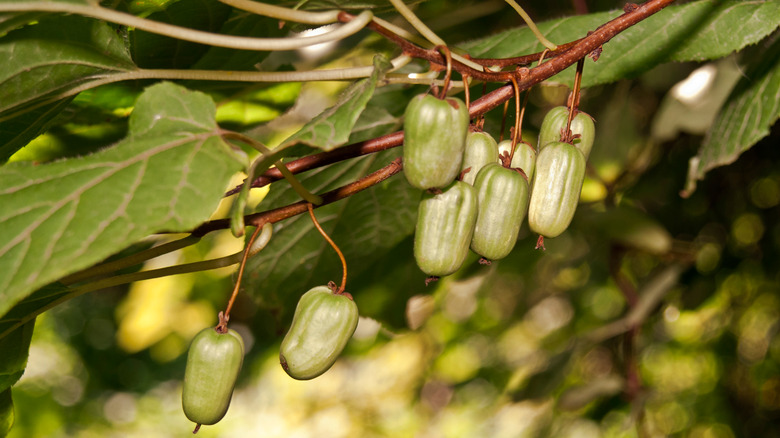4 Popular Types Of Kiwi Fruit, Explained
If you want more variety in your roster of fruits for salads and smoothies, consider buying kiwis more often. Edible from its skin to its flesh, this palm-sized fruit is a fantastic option because it's packed with nutrients, specifically vitamins C and K. Its peel even has a higher vitamin C content and is 50% more fibrous than its flesh, so if you don't mind biting into its slightly fuzzy skin, there's no danger at all in eating kiwi peel. Throw it whole into a blender as well to make a smoothie and enjoy its complete health benefits without generating extra kitchen waste.
Strawberries, bananas, and pineapples are usually mentioned when describing the flavor of a ripe kiwi. Native to China, kiwis are sweet and tangy, making them great additions to dishes where the other mentioned fruits are also used, from salads to salsa and compotes. Just like pineapple, kiwi juice can be used to marinate chicken since it contains the meat-tenderizing enzyme actinidin. However, it's not advisable to add kiwi to milk-based drinks and desserts other than as a garnish since that same enzyme can cause the dairy to form clots and give the food an unappetizing texture.
There are as many as 40 known varieties of this fruit, all of which differ in taste and appearance. You should get to know the differences between the most popular ones. That way, the next time you spot any of them in the market, you'll know which ones you want to stock up on. Here are the four most common types of kiwis, explained.
Green kiwis
Green kiwis (Actinidia deliciosa var. Hayward) are the most recognizable variant of this fruit. They're oval-shaped and come with a fuzzy brown peel and flesh that's bright green in color, with plenty of tiny black seeds surrounding their core. Green kiwis also have that sweet and mildly tart flavor that the fruit is known for.
This type of kiwi is a great source of vitamin C, with every 100 grams of green kiwi containing 92.7 milligrams of ascorbic acid (aka vitamin C), according to a 2018 article published in the European Journal of Nutrition — that's even higher than the amount offered by oranges, strawberries, and papayas. Next to bananas and gold kiwis, it also has a higher potassium content than most other frequently consumed fruits. It's a great choice, too, for people who want to reduce their sugar intake while still enjoying something sweet since green kiwis only have 9 grams of sugar per 100 grams of fruit.
Green kiwis sport a brown, hairy peel whether they're mature or immature. That means you must examine them closely so you can select the ripest ones in a grocery display and enjoy each fruit at its tastiest. Choose those that are plump-looking and gently feel them. A ripe kiwi shouldn't feel mushy — that's a sign that it is overripe — but it shouldn't feel too firm, either. Exert a light pressure on it with your fingertips and look for a slight give in its flesh. Sniff the fruit as well since ripe green kiwis give off a light, sweet scent.
Gold kiwis
When you hear "gold kiwi," it's probably the brand Zespri's SunGold kiwi that comes to mind. This fruit is a more recently developed variety: After a bacterial disease threatened New Zealand's kiwi industry in 2010, scientist Russell Lowe took charge in the cultivation of a more resistant kiwifruit, and the result is the Gold 3, which is now known as SunGold. Zespri owns the intellectual property rights to it.
Not only is it globally distributed, but SunGold kiwi is at the center of Zespri's years-long legal battle with Chinese growers. Since the brand discovered in 2016 that a Chinese entrepreneur had smuggled SunGold kiwi budwood to Sichuan, China (where most of the world's kiwis are grown), Zespri now estimates that there are around 7,850 hectares of unauthorized plantings of this kiwi variety in the Asian country as of 2023 — an area that is close in size to the SunGold farm in New Zealand.
Regardless of where the gold kiwi in your local grocery store came from, it features a smooth peel that feels thinner than the green kiwi's. Its flesh is also softer, with a golden hue that fits its name. It has a higher sugar content as well and its sweetness has been compared to the flavorful intensity of ripe mangoes. Between green and gold kiwis, eating the latter like an apple, complete with the peel, may feel and taste more pleasant, but adding them together to your fruit salad allows their subtle taste differences to give the dish a more complex sweetness.
Kiwi berries
Something you may not see as frequently are kiwi berries (Actinidia arguta), which are also referred to as mini kiwis, baby kiwis, hardy kiwis, and even cocktail kiwis. Kiwi berries are native to East Asia but thrive in the temperate climate of the U.S. Northwest region. They are autumnal crops that have delicate flesh, which makes storing and transporting them over long distances difficult. Because of their much shorter shelf life, you don't see kiwi berries in stores when they're not in season.
These fruits' characteristics draw comparisons to grapes, starting from their petite size and how they grow on vines in small clusters to their smooth, thin, and hairless peel that comes in different tints of green and is sometimes mottled with purple and brown. But when you slice a mini kiwi open, you will see how its small seeds form the same pattern around a cream-colored center that you'd also spot when you halve a larger kiwifruit. Its aromatic lime-green flesh is also much sweeter than that of regular kiwis, which makes it an excellent choice for making wines and jams.
In terms of nutritional content, kiwi berries are great sources of vitamins A, C, and E. They also have higher amounts of antioxidant phenolics and ascorbate than the larger varieties, according to a 2015 study published in the Journal of Functional Foods. These bioactive compounds are more concentrated in the fruit's peel, giving you another great reason to pop them into your mouth whole.
Arctic kiwis
Even smaller and more delicate than kiwi berries are the Arctic kiwis (Actinidia kolomikta). Also known as super-hardy kiwis, they can survive wintry temperatures down to -40 degrees Fahrenheit. Like other kiwi varieties, you can eat them whole and unpeeled since their thin, green skin is edible, but compared to the kiwi berries' tropical sweetness, Arctic kiwis have more floral notes in their flavor. A 2022 study published in Plants also reported that they are similarly rich in ascorbic acid and bioactive compounds with antioxidative properties, specifically flavan-3-ols, phenolic acids, flavones, and flavonols.
This kiwi species has a low overall yield compared to others, so finding its fruits in the market is even rarer than finding kiwi berries. The good news is you can cultivate this plant in your backyard, provided that it's placed where it won't be exposed to the sun and the soil is properly drained. It doesn't require much space, either. In exchange for your care, it grows vines that feature beautiful foliage, with its ornamental leaves displaying white and flamingo-pink coloration.
When it comes to growing fruits, this plant can produce crops earlier than the kiwi berry. However, Arctic kiwis also tend to fall to the ground once they've ripened, which is a reason why growing them commercially is difficult. Depending on the variety you get, the Arctic kiwi plant can yield mature fruits anytime between the beginning of August and the end of the month.
